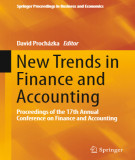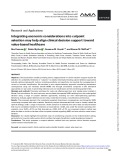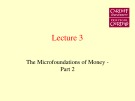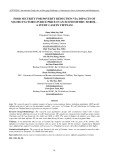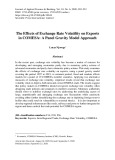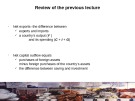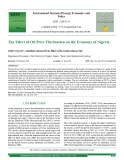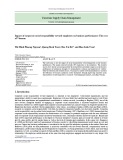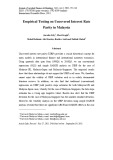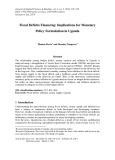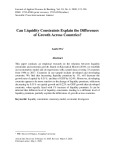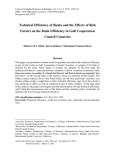
A monetary model
-
Part 1 of ebook "New trends in finance and accounting: Proceedings of the 17th annual conference on finance and accounting" provides readers with contents including: the theory of debt-deflation, a possibility of incompatibility of goals of monetary policy; gold versus stocks as an inflationary hedge, the case of spain; foreign capital inflows and stock market development in Turkey; count data modeling about relationship between Dubai housing sales transactions and financial indicators;...
 394p
394p  mocthanhdao0210
mocthanhdao0210
 19-11-2023
19-11-2023
 8
8
 5
5
 Download
Download
-
In ebook "Currencies, capital flows, and crises: A post Keynesian analysis of exchange rate determination" the traditional approach is reviewed and critiqued and the alternative is then built by studying the psychology of the market and balance of payments questions. The central model has at its core Keynes’ analysis of the macroeconomy and it assumes neither full employment nor balanced trade over the short or long run.
 166p
166p  loivantrinh
loivantrinh
 29-10-2023
29-10-2023
 7
7
 4
4
 Download
Download
-
Ebook "Environmental accounting in theory and practice" was to explore the need for and methodologies of adjusting national accounts for environmental reasons. National accountants had faced mounting criticism that conventional accounting neglected new scarcities in natural capital, as well as the social cost of environmental degradation. The result of their deliberations was a draft manual, later issued by the United Nations Statistics Division (UNSD) as a handbook of Integrated Environmental and Economic Accounting.
 451p
451p  loivantrinh
loivantrinh
 29-10-2023
29-10-2023
 6
6
 3
3
 Download
Download
-
Clinical prediction models providing binary categorizations for clinical decision support require the selection of a probability threshold, or “cutpoint,” to classify individuals. Existing cutpoint selection approaches typically optimize test-specific metrics, including sensitivity and specificity, but overlook the consequences of correct or incorrect classification.
 11p
11p  vighostrider
vighostrider
 25-05-2023
25-05-2023
 3
3
 2
2
 Download
Download
-
Lecture Money, Banking & Finance - Lecture 3: The Microfoundations of Money - Part 2. The following will be discussed in this chapter: Dissatisfaction with ad hoc formulation and MIUF approach, OLG - a theory of monetary exchange under Laissez Faire, Critical evaluation of OLG - purely a store of value, Intergenerational contracts, Legal restrictions, Another look at MIUF and CIA.
 28p
28p  runordie1
runordie1
 10-05-2022
10-05-2022
 19
19
 2
2
 Download
Download
-
Lecture The economics of Money, Banking and Financial markets: Chapter 23 The Keynesian Framework and the ISLM Model. The ISLM model is valuable not only because it can be used in economic forecasting but also because it provides a deeper understanding of how government policy can affect aggregate economic activity. In Chapter 23 we use it to evaluate the effects of monetary and fiscal policy on the economy and to learn some lessons about how monetary policy might best be conducted.
 14p
14p  runordie1
runordie1
 10-05-2022
10-05-2022
 12
12
 2
2
 Download
Download
-
The research aimed to evaluate impacts of macro socio-economic factors including population, GDP growth, inflation and interest rates on the dependant variable “rice price” in Vietnam. We will concentrate on Vietnam case and just use Thailand data as references to compare to Vietnam. The research used quantitative design with econometric model with 4 macro economic factors affecting rice price to reflex food security.
 17p
17p  alucardhellsing
alucardhellsing
 04-05-2022
04-05-2022
 15
15
 1
1
 Download
Download
-
Chapter 10 Aggregate demand I: Building the IS-LM Model. In this chapter you will learn the theory of liquidity preference as a short-run theory of the interest rate, analyze how monetary policy affects interest rates and aggregate demand, analyze how fiscal policy affects interest rates and aggregate demand, discuss the debate over whether policymakers should try to stabilize the economy.
 47p
47p  lovebychance02
lovebychance02
 04-05-2021
04-05-2021
 25
25
 1
1
 Download
Download
-
The objective of this chapter is to understand fluctuations in inflation and real output and how central banks use conventional interest-rate policy to stabilize them. We will develop a macroeconomic model of fluctuations in the business cycle in which monetary policy plays a central role.
 34p
34p  tradaviahe15
tradaviahe15
 23-02-2021
23-02-2021
 11
11
 2
2
 Download
Download
-
In the recent past, exchange rate volatility has become a matter of concern for developing and emerging economies partly due to monetary policy actions of advanced economies and partly due to domestic policy actions. This study examines the effects of exchange rate volatility on exports, using a panel gravity model covering the period 1997 to 2019, to estimate pooled, fixed and random effects models for a panel of 19 COMESA member countries.
 21p
21p  mmlemmlem_124
mmlemmlem_124
 22-12-2020
22-12-2020
 15
15
 1
1
 Download
Download
-
Lecture 32 - Monetary and fiscal policy. In this chapter you will learn the theory of liquidity preference as a short-run theory of the interest rate, analyze how monetary policy affects interest rates and aggregate demand, analyze how fiscal policy affects interest rates and aggregate demand, discuss the debate over whether policymakers should try to stabilize the economy.
 34p
34p  larachdumlanat124
larachdumlanat124
 28-11-2020
28-11-2020
 18
18
 1
1
 Download
Download
-
Lecture 13: Open economy - II. In this chapter you will learn the theory of liquidity preference as a short-run theory of the interest rate, analyze how monetary policy affects interest rates and aggregate demand, analyze how fiscal policy affects interest rates and aggregate demand, discuss the debate over whether policymakers should try to stabilize the economy.
 22p
22p  larachdumlanat124
larachdumlanat124
 28-11-2020
28-11-2020
 15
15
 0
0
 Download
Download
-
The portfolio-balance approach to exchange rate determination is part of the Asset Market Models and is largely attributed to economists after 1973 when the exchange rate became flexible (market determined). This article first introduces the setting of the model embedded in the portfolio balance approach that encompasses two assets (money and bonds), which deviates a little from the models and approaches used for the monetary approach to the balance of payment, the overshooting model, and from the associated market equilibria.
 22p
22p  nguyentanloc09
nguyentanloc09
 17-10-2020
17-10-2020
 33
33
 0
0
 Download
Download
-
The aim of the study is to find the empirical analyses of the impact of oil price fluctuation on the monetary instrument in Nigeria, by looking at their relationships. Specifically, we analyzed the role of Exchange rate, Inflation, Interest rate and how they respond to shocks in oil price. We explored the frequently used Toda–Yamamoto model (TY), by adopting the TY modified Wald (MWALD) test approach to causality, forecast error variance decomposition (FEVD) and impulse response functions (IRFs).
 8p
8p  kethamoi7
kethamoi7
 15-08-2020
15-08-2020
 28
28
 2
2
 Download
Download
-
This paper, using a standard model of monetary delegation, highlights the relationship between transparency and conservativeness of central banks. Precisely, we show that a lack of transparency about the output objective of central banks positively affects the optimal degree of conservativeness of the central bank. Empirical analysis confirms the theoretical link highlighted in this study.
 10p
10p  nguyenanhtuan_qb
nguyenanhtuan_qb
 09-07-2020
09-07-2020
 24
24
 2
2
 Download
Download
-
The paper studies the monetary approach to exchange rate for a group of five Pacific Basin economies, using quarterly data for the period of post – Asian financial crisis. Estimated results reveal that for Thailand and the Indonesia which were most affected by Asian financial crisis, monetary model did not work for explaining exchange rate movements.
 10p
10p  tohitohi
tohitohi
 22-05-2020
22-05-2020
 17
17
 0
0
 Download
Download
-
Uncovered interest rate parity (UIRP) provides a crucial theoretical concept for many models in international finance and international monetary economics. Using quarterly data span from 1998Q1 to 2010Q3, we run conventional regressions (OLS) and simple GARCH analysis on UIRP for the case of Malaysia-UK, Malaysia-Japan and Malaysia-Singapore. The empirical results show that these relationships do not support the UIRP in all cases. We, therefore, cannot reject the validity of UIRP violation such as in widely documented literature reviews.
 20p
20p  nguyenminhlong19
nguyenminhlong19
 21-04-2020
21-04-2020
 11
11
 1
1
 Download
Download
-
The relationship among budget deficit, money creation and inflation in Uganda is analyzed using a triangulation of Vector Error Correction model (VECM) and pair-wise Engel-Granger non- causality test techniques over the period 1999Q4 - 2012Q3. Results suggest that fiscal deficits do not seem to necessarily trigger inflation in the short-run, but in the long-run. Also, unidirectional causality running from inflation to the fiscal deficit, from money supply to the fiscal deficit, and a feedback causal effect between money supply and inflation in the short-run are found.
 14p
14p  cothumenhmong4
cothumenhmong4
 24-03-2020
24-03-2020
 18
18
 3
3
 Download
Download
-
This paper conducts an empirical research on the relations between liquidity constraints and economic growth. Based on Kiyotaki & Moore (2019), we establish our econometric model and do regressions with a panel data covering 33 countries from 1996 to 2017.
 12p
12p  cothumenhmong4
cothumenhmong4
 24-03-2020
24-03-2020
 34
34
 2
2
 Download
Download
-
Technical efficiency, credit risk, monetary risk, systematic and unsystematic risk This paper uses production frontier model to generate and analyse the technical efficiency scores for the banks in Gulf Cooperation Council Countries. A sample of 52 banks is selected for the study. Three stages of analysis are adopted. At the first stage, the technical efficiency is analysed between countries to derive variations of between banks from one country to another. It’s found that Kuwaiti and Emirati banks are regionally best performers.
 14p
14p  trinhthamhodang2
trinhthamhodang2
 21-01-2020
21-01-2020
 41
41
 3
3
 Download
Download
CHỦ ĐỀ BẠN MUỐN TÌM









